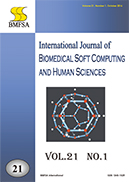巻号一覧

27 巻 (2022)
- 2 号 p. 29-
- 1 号 p. 1-
27 巻, 1 号
選択された号の論文の3件中1~3を表示しています
- |<
- <
- 1
- >
- >|
-
Solaiman AHMED, Manabu NII2022 年 27 巻 1 号 p. 1-12
発行日: 2022年
公開日: 2022/12/15
ジャーナル フリーMultiple accelerometers (chest and wrist) and physiological sensors (electrocardiogram (ECG) and electrodermal activity (EDA)) based activity classification systems have been proposed to classify those activities which are too abstruse to classify with the accelerometer-based system only. “ActiGraph” count value as well as several features of ECG and EDA were extracted from 14 persons with an open-source dataset named “PPG Field Study Dataset”. The activities were considered as different types (type A, type B, type C) based on the movement intensity of the wrist and the chest. The features were fitted to machine learning (ML) algorithms with accelerometer features only and both (count and physiological feature). In the case of type A activities (no chest and wrist movement), classification with accelerometers only and both, the accuracy was 89.3% with weighted K-NN and 100% with linear regression, respectively. In the case of classification between type B (hand soccer, cycling, driving, lunch) activities with accelerometers only and both, the accuracy was 66.1% and 89.3% with linear and quadratic support vector machine (SVM) respectively. In the case of classification between type C activities (stair and walk) with accelerometers only and both, the accuracy was 64.3% and 82.1% with linear discrimination and SVM (linear) classifier respectively. All the results for type A and type C activities classification were generated with leave one out cross-validation, and classification between type B activities was classified with 50-fold cross-validation to avoid overfitting where Bayesian optimizer tuned the hyperparameters of the ML classifiers.抄録全体を表示PDF形式でダウンロード (1018K) -
Ummul Afia SHAMMI, Md Atiqur Rahman AHAD2022 年 27 巻 1 号 p. 13-20
発行日: 2022年
公開日: 2022/12/15
ジャーナル フリーSleep is an important activity for every human being. Proper and balanced periods of sleep are essential for an individual’s health state. Sleep posture is related to the quality of sleep. Therefore, during sleep, it is crucial to study the sleep postures and limbs’ movements. For some diseases, body positions and movements are intra-related (i.e., restless legs syndrome and patellofemoral pain syndrome). We propose a sleep monitoring system based on ultrasonic sensors. Our system does not need any on-body sensors to wear, nor does it need any kind of additional action from the users outside the daily routine. Ultrasonic sensors can be used for finding out the distance from the sensor to any object/subject that is in front of it. By wiring ultrasonic sensors with an Arduino Mega board, we can calculate this distance. Later, we put that sensor value on to ‘Processing’ software for further data analysis. The main contributions of this paper are to find if the bed is empty or not, if the person is sitting or lying on the bed, and to find out at which posture the subject is sleeping. We present the result of our analysis as a medical report, which will help a doctor for finding the sleeping posture of a person and what might be the reason for body pain, fatigue, or other sleep disorders. Our proposed method can be used in normal households with a minimal arrangement.抄録全体を表示PDF形式でダウンロード (578K) -
Wenxin ZHANG, Peixin JU, Tong LI, Bairun DU, Xiangxiang LANG, Wei WANG ...2022 年 27 巻 1 号 p. 21-27
発行日: 2022年
公開日: 2022/12/15
ジャーナル フリーThis study introduces a hybrid method to analyze the abnormal information in big data to precisely monitor, distinguish and exclude anomaly. First, statistical data anomalies are defined and strictly analyzed based on probability distribution events for the purpose of determination of anomaly analysis theory. Then, deep learning is used to monitor and distinguish abnormal data and link the statistical anomaly with practical risk management problems in the public healthcare. Last, three performance indicators from some public hospital are chosen for experiment to check the effectiveness of the proposed method in data anomaly monitoring, distinguishing and exclusion. The experiment result shows the availability of this method in data anomaly identification, processing and control.抄録全体を表示PDF形式でダウンロード (832K)
- |<
- <
- 1
- >
- >|